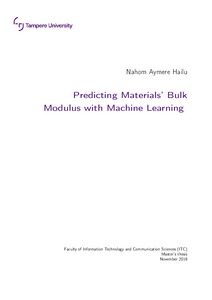Predicting Materials’ Bulk Modulus with Machine Learning
Hailu, Nahom Aymere (2020)
Hailu, Nahom Aymere
2020
Degree Programme in Information Technology, MSc (Tech)
Informaatioteknologian ja viestinnän tiedekunta - Faculty of Information Technology and Communication Sciences
This publication is copyrighted. You may download, display and print it for Your own personal use. Commercial use is prohibited.
Hyväksymispäivämäärä
2020-02-12
Julkaisun pysyvä osoite on
https://urn.fi/URN:NBN:fi:tuni-202001221450
https://urn.fi/URN:NBN:fi:tuni-202001221450
Tiivistelmä
In material science, experiments and high-throughput models often consume a large amount of calendar time and computation resources, respectively. It is, therefore, essential to consider novel methods to accelerate the process of discovering and designing new materials. Design of materials with machine learning has gained increasing attention and resulted in significant improvements in terms of time and accuracy.
Machine learning is a methodology for automating the creation of analytical models. By using algorithms that iteratively learn from data, machine learning allows computers to find hidden patterns without being explicitly programmed. This thesis aims to construct a regression machine learning model to estimate the elastic bulk modulus constant of materials. The model uses features based on material composition and crystal structure. Previous researches that have applied machine learning to material property databases have developed different feature extraction methods. Using these existing methods, we developed a feature selection algorithm to find the best features for predicting the bulk modulus.
Matminer, a data mining toolkit, was used in this work for feature extraction and data retrieving. Using this toolkit allowed us to compare the result of multiple feature extraction techniques.
In this experiment, we discovered the best feature extraction methods for predicting the bulk modulus of various materials. Moreover, we constructed a regression model capable of predicting it with a relative mean error of 10.4%.
Machine learning is a methodology for automating the creation of analytical models. By using algorithms that iteratively learn from data, machine learning allows computers to find hidden patterns without being explicitly programmed. This thesis aims to construct a regression machine learning model to estimate the elastic bulk modulus constant of materials. The model uses features based on material composition and crystal structure. Previous researches that have applied machine learning to material property databases have developed different feature extraction methods. Using these existing methods, we developed a feature selection algorithm to find the best features for predicting the bulk modulus.
Matminer, a data mining toolkit, was used in this work for feature extraction and data retrieving. Using this toolkit allowed us to compare the result of multiple feature extraction techniques.
In this experiment, we discovered the best feature extraction methods for predicting the bulk modulus of various materials. Moreover, we constructed a regression model capable of predicting it with a relative mean error of 10.4%.
